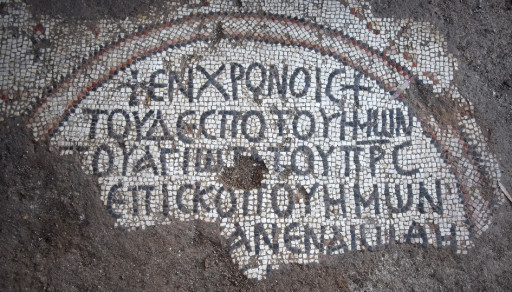Archeologists uncovered 1,500-year-old mosaics believed to be above Peter and Andrew's home
GALILEE, Israel, Oct. 21, 2021 (GLOBE NEWSWIRE) -- Archeologists have uncovered for the first time mosaic floors from a lost, legendary basilica reportedly built over the house of Jesus' apostles Peter and Andrew in biblical Bethsaida. According to archeological director Mordechai Aviam, "We identified a large apse in the east and uncovered two inscriptions. While the smaller one mentions a deacon and a building project, the larger inscription is a half medallion and speaks of the bishop and reconstruction of the building." The excavation known as the El Araj Excavation Project is a joint undertaking of the Kinneret Institute for Galilean Archeology at Kinneret College and Nyack College, NY. It is sponsored by the Center for the Study of Ancient Judaism and Christian Origins (CSAJCO) and the Museum of the Bible in Washington, D.C.
Next year, work on the site will resume, buildings from the Roman period village will be excavated, and the entire church will be cleared with the aim to answer the question: "Who buried the Byzantine Church of the Apostles?"
HISTORICAL BACKGROUND: In 724 C.E., a Bavarian bishop named Willibald visited holy sites along the Sea of Galilee in his pilgrimage to the Holy Land. He reported: "And thence they went to Bethsaida, the residence of Peter and Andrew, where there is now a church on the site of their house."
Since 2016, the Kinneret Institute for Galilee Archeology at Kinneret College, and Nyack College, New York, have conducted excavations led by Mordechai Aviam and Steven Notley at the site of Beit HaBek (al-A'raj) in an attempt to identify the lost city of Bethsaida. Not only have they discovered a large and previously unknown Jewish village dated to the Roman period but also a large basilica that measures 27x16m from the Byzantine period. The excavators have now identified this church with the Church of the Apostles mentioned by Bishop Willibald.
To the surprise of the excavators, although the outer walls were preserved to a height of one meter, not a single opening was identified. It is possible that directly on the same walls of the church, a sugar factory was erected in the Middle Ages. Its builders had no interest in the mosaics and so the interior area was filled with dirt, inadvertently burying the church.
It is also possible that the remains of the church were intentionally enclosed by a wall after it was destroyed in the earthquake of 749 C.E. It was cleaned and renewed in such a way that the church was preserved and commemorated. Other churches in the region were also abandoned, but perhaps because of the great importance attached to the house of Peter and Andrew, the basilica in Bethsaida was especially preserved.
- ghost
-

 1
1




Recommended Comments
There are no comments to display.
Join the conversation
You can post now and register later. If you have an account, sign in now to post with your account.
Note: Your post will require moderator approval before it will be visible.